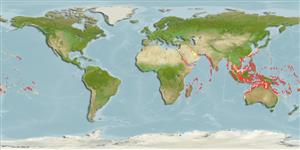Environment: milieu / climate zone / depth range / distribution range
Ökologie
seewasser riff-verbunden; tiefenbereich 0 - 60 m (Ref. 128797). Tropical; 32°N - 32°S, 30°E - 132°W
Indo-Pacific: Red Sea south to Natal, South Africa (Ref. 4420) and east to the Line, Marquesan and Tuamoto islands, north to southern Japan, south to the southern Great Barrier Reef and New Caledonia.
Length at first maturity / Size / Gewicht / Alter
Maturity: Lm 15.7, range 8 - ? cm
Max length : 30.0 cm TL Männchen/unbestimmt; (Ref. 2334); common length : 26.0 cm TL Männchen/unbestimmt; (Ref. 5450)
Rückenflossenstacheln (insgesamt): 3; Rückenflossenweichstrahlen (insgesamt): 24-27; Afterflossenstacheln 0; Afterflossenweichstrahlen: 20 - 24. This species is distinguished by the following characters: front of eye without the elongate groove; enlarged scales above the pectoral-fin base and just behind the gill opening to form a flexible tympanum; the scales of the caudal peduncle with 2 longitudinal rows of large anterior-projecting spines; the slightly rounded caudal fin with compressed peduncle; head and body colour green to brown with diagonally curved orange lines and a large round black blotch covering most of the caudal-fin base; rays of soft dorsal, anal and pectoral fins orange and also the caudal fin (Ref. 10920, 9770).
Adults which are territorial in nature occur in coral-rich areas of deep lagoon and seaward reefs from the lower surge zone to at least 50 meters (Ref. 48637). They feed on a variety of benthic organisms such as algae, echinoderms, fishes, mollusks, tunicates, sponges, and hydrozoans. Eggs are laid as one cluster in a shallow excavation on sand or rubble along channels. (Ref. 1602). Marketed fresh and dried-salted (Ref. 9770).
Spawning behaviour may involve loose aggregations and nesting occurs in channels. The eggs are laid in a single spongy cluster in a shallow excavation in rubble or sand. Hatching occurs at night (Ref. 37816). Nests are guarded by one or at times two adults (Ref. 9778).
Matsuura, K., 2001. Balistidae. Triggerfishes. p. 3911-3928. In K.E. Carpenter and V. Niem (eds.) FAO species identification guide for fishery purposes. The living marine resources of the Western Central Pacific. Vol. 6. Bony fishes part 4 (Labridae to Latimeriidae), estuarine crocodiles. FAO, Rome. (Ref. 9770)
IUCN Rote Liste Status (Ref. 130435)
Bedrohung für Menschen
Traumatogenic (Ref. 4420)
Nutzung durch Menschen
Fischereien: kommerziell; Aquarium: Kommerziell
Mehr Information
ReferenzenAquakulturAquakultur ProfilZuchtlinienGenetikElectrophoresesVererbbarkeitKrankheitenVerarbeitungNutrientsMass conversion
Tools
Zusatzinformationen
Download XML
Internet Quellen
Estimates based on models
Preferred temperature (Ref.
123201): 25.1 - 29.1, mean 28 °C (based on 1034 cells).
Phylogenetic diversity index (Ref.
82804): PD
50 = 1.0000 [Uniqueness, from 0.5 = low to 2.0 = high].
Bayesian length-weight: a=0.03548 (0.02121 - 0.05935), b=3.00 (2.86 - 3.14), in cm total length, based on LWR estimates for this species & (Sub)family-body (Ref.
93245).
Trophic level (Ref.
69278): 3.4 ±0.42 se; based on food items.
Widerstandsfähigkeit (Ref.
120179): mittel, Verdopplung der Population dauert 1,4 - 4,4 Jahre. (Preliminary K or Fecundity.).
Fishing Vulnerability (Ref.
59153): Low vulnerability (20 of 100).
Nutrients (Ref.
124155): Calcium = 45.5 [19.1, 112.8] mg/100g; Iron = 0.609 [0.316, 1.378] mg/100g; Protein = 18.4 [16.3, 20.5] %; Omega3 = 0.118 [0.060, 0.227] g/100g; Selenium = 34.2 [17.9, 70.8] μg/100g; VitaminA = 56.4 [16.5, 196.9] μg/100g; Zinc = 1.07 [0.73, 1.59] mg/100g (wet weight);
